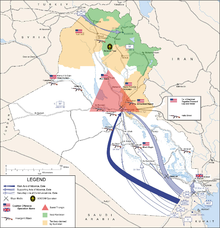
The United States Central Command is one of the eleven unified combatant commands of the U.S. Department of Defense. It was established in 1983, taking over the previous responsibilities of the Rapid Deployment Joint Task Force (RDJTF).

The Second Battle of Fallujah, codenamed Operation Phantom Fury, and Operation al-Fajr, was an American-led offensive of the Iraq War that lasted roughly six weeks, starting 7 November 2004. Marking the highest point of the conflict against the Iraqi insurgency, it was a joint military effort carried out by the United States, the Iraqi Interim Government, and the United Kingdom. Within the city of Fallujah, the coalition was led by the U.S. Marine Corps and U.S. Army, the battle was later described as "some of the heaviest urban combat U.S. military have been involved in since the Battle of Huế City in Vietnam in 1968".
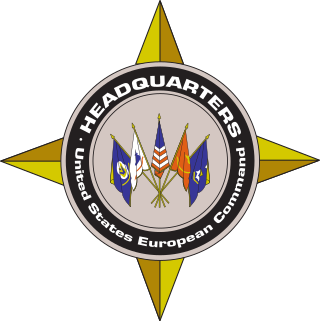
The United States European Command (EUCOM) is one of the eleven unified combatant commands of the United States military, headquartered in Stuttgart, Germany. Its area of focus covers 21,000,000 square miles (54,000,000 km2) and 51 countries and territories, including Europe, Russia, and Greenland. The Commander of the United States EUCOM simultaneously serves as the Supreme Allied Commander, Europe (SACEUR) within NATO, a military alliance. During the Gulf War and Operation Northern Watch, EUCOM controlled the forces flying from Incirlik Air Base.

The 5th Marine Regiment is an infantry regiment of the United States Marine Corps based at Marine Corps Base Camp Pendleton, California. It is the most highly decorated regiment in the Marine Corps and falls under the command of the 1st Marine Division and the I Marine Expeditionary Force.

United States Army Forces Command (FORSCOM) is the largest United States Army command. It provides expeditionary, regionally engaged, campaign-capable land forces to combatant commanders. Headquartered at Fort Liberty, North Carolina, FORSCOM consists of more than 750,000 active Army, U.S. Army Reserve, and Army National Guard soldiers. FORSCOM was created on 1 July 1973 from the former Continental Army Command (CONARC), who in turn supplanted Army Field Forces and Army Ground Forces.

The 11th Corps Signal Brigade of the United States Army is an element of Army Forces Command. It is based at Fort Cavazos, Texas. The unit mascot is the Thunderbird, a hawk-like bird perched upon a globe shooting thunderbolts out of its eyes. Soldiers in this unit call themselves "The Thunderbirds."

Multi-National Corps – Iraq (MNC-I) was a formerly multinational, later U.S. only, army corps created on 15 May 2004, fighting the Iraq War. Its superior body, the Multi-National Force-Iraq (MNF-I) had replaced Combined Joint Task Force 7 on May 15, 2004. The change was made due to "concerns that had existed for some period of time, that the Combined Joint Task Force 7 headquarters was not sufficient to handle the range of military operations in Iraq, including peace support, civil military operations, and at the same time conduct strategic engagement such as talking to the sheiks and talking to the political authorities."

Below is an estimated list of the major units deployed within the Multi-National Force – Iraq and other United States military units that were operating in Iraq under the U.S. Central Command (USCENTCOM) in 2009, during the Iraq War.

The United States Marine Corps is organized within the Department of the Navy, which is led by the Secretary of the Navy (SECNAV). The most senior Marine commissioned officer is the Commandant of the Marine Corps, responsible for organizing, recruiting, training, and equipping the Marine Corps so that it is ready for operation under the command of the unified combatant commanders. The Marine Corps is organized into four principal subdivisions: Headquarters Marine Corps, the Operating Forces, the Supporting Establishment, and the Marine Forces Reserve.

R. Steven Whitcomb is a retired United States Army lieutenant general. He was commissioned as a second lieutenant upon graduation from the University of Virginia in 1970. In his final assignment he served as Inspector General of the United States Army.
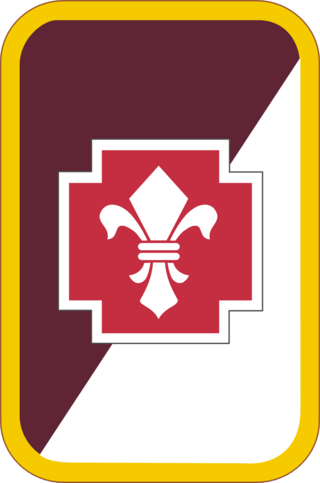
The 62nd Medical Brigade, formerly the 62nd Medical Group of the United States Army is a unit of the Army Medical Department and I Corps and Fort Lewis. It is based entirely at Joint Base Lewis-McChord, Washington. Currently, the brigade is commanded by Colonel Robert S. Heath, the first Physician Assistant in history to command a US Army medical brigade, and Command Sergeant Major Michael P. Morrill.
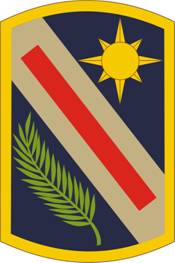
The 321st Sustainment Brigade is a sustainment brigade of the United States Army Reserve.
Combined Joint Task Force 7 was the interim military formation that directed the U.S. effort in Iraq between June 2003 and May 2004. It replaced the Coalition Forces Land Component Command on 14 June 2003. CFLCC was the land forces component of United States Central Command that carried out the initial invasion of Iraq, was established by Commander, U.S. Army Forces Central Command, in 2002/3, to oversee two corps-sized organizations, I Marine Expeditionary Force and V Corps. These two corps-level formations carried out Operation Iraqi Freedom which began on 20 March 2003.
In 2009, the United States and NATO International Security Assistance Force (ISAF) coalition, along with Afghan National Army forces, continued military operations against the Taliban in Afghanistan. 2009 marks the eighth year of the War in Afghanistan, which began late in 2001. And 75th ranger regiment is also in Afghanistan as of 2018

This is the order of battle for the invasion of Iraq during the Iraq War between coalition forces and the Iraqi Armed Forces; Fedayeen Saddam irregulars; and others between March 19 and May 1, 2003.

The United States Army Central, formerly the Third United States Army, commonly referred to as the Third Army and as ARCENT, is a military formation of the United States Army that saw service in World War I and World War II, in the 1991 Gulf War, and in the coalition occupation of Iraq. It is best known for its campaigns in World War II under the command of General George S. Patton.

Lieutenant General Sean Barry MacFarland is a retired three-star general who served in the United States Army.

The Battle of Kuwait International Airport occurred on February 27, 1991, during the 1st Gulf War. It was a tank battle between the United States and Iraq. Despite being a very large battle it is often overlooked compared to the other battles which took place during the war. No less than elements of 18 divisions total participated in this battle. U.S. Army Special Forces units and multiple Iraqi Commando units were also in theatre. In reality the battle took place over a span of three days despite the primary battle at Kuwait International Airport lasting only one day. Much of the combat actually took place en route to the airport. The battle featured the "Reveille Engagement" which went on to become the biggest and fastest tank battle in United States Marine Corps' entire history.
Combined Joint Task Force 180 was a provisional multinational land formation, primarily made up of units from the United States Army, that fought in the War in Afghanistan (2001–2021), especially in the initial invasion phase of 2001-2002. It was active from May 2002 to 2003/05. It was the senior headquarters in country reporting to United States Central Command.
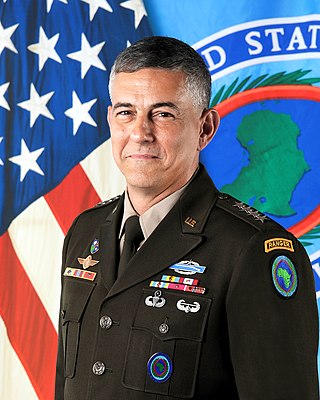
Stephen J. Townsend is a United States Army four-star general who served as Commander United States Africa Command from 26 July 2019 to 8 August 2022. He previously commanded the United States Army Training and Doctrine Command from March 2018 until June 2019 and XVIII Airborne Corps from May 2015 until January 2018.
